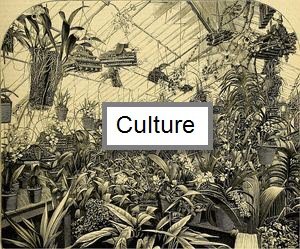Indoors or Outside, Proper Exposure Coaxes Orchids to Flower
LIGHT DRIVES THE PHOTOSYNTHETIC process in plants, transforming nutrients into food they use to grow and flower. It is perhaps the first factor you should consider when determining if you might be able to provide a suitable environment for growing orchids, whether it is in a home, on a sun porch, in a greenhouse, or outdoors.
If you choose to grow orchids in a home or apartment, the natural light source will ordinarily be through windows or skylights. In order to be a successful orchid grower, you should scout your home for the brightest locations or consider options for augmenting or substituting with artificial light. For most indoor growers, providing good light is their greatest challenge, but it is absolutely possible and is successfully accomplished by many.
If you are growing your orchids indoors on windowsills or near windows, keep in mind that you must locate the plants rather close to the glass to maximize the amount of light they receive. Light intensity diminishes considerably as you move even a foot or two from the panes. Windows with south exposures are reliably bright throughout the day and around the seasons. East windows are always popular, as orchids seem to thrive with morning sun. West windows can work well too, but some care may be necessary to protect plants from the hot, late afternoon rays. North windows would be the last choice for most, however I have known a grower or two who were successful with them.
Windowsill growers usually need to forgo window coverings in the day so their plants can receive maximum light. In choosing the best location for their windowsill conservatory, indoor growers should also note the location of nearby trees, shrubs and buildings outdoors and consider how they may affect the light received through the window in any particular season of the year.
If you do not have a suitable window where you can set up orchid keeping, consider the alternative of artificial light. Many types of orchids can thrive under fluorescent light and the manufactured stands and shelves produced for growing plants in this manner make the task almost effortless. Situating one of these units in front of a large window or sliding door can provide the advantages of both windowsill culture and growing under artificial light. While incandescent bulbs are unsuitable for plant culture, some newer types of bulbs can produce excellent results. Still, it is hard to beat the ease and convenience of a fluorescent light stand, particularly for the beginner.
Depending on exposure, most growers using sun porches, and particularly those who grow out of doors or in greenhouses face the opposite challenge. Typically, they must devise ways to shade their plants from getting too much light.
Light is measured by intensity and duration. Light intensity is measured in foot-candles, which, perhaps obviously, is the amount of light produced by a candle at a distance of one foot. Full sun on a summer day may produce 10,000 to 12,000 foot-candles of light. In nature, most epiphytic tropical orchids are protected from direct sun and thrive with 2,000 to 3,000 foot-candles of light. As a general guide, the duration of good light should be for 10 to 12 hours, adjusted seasonally so that there are two or three hours less during the winter months.
Few orchid growers have a light meter or actually bother to measure the amount of light their plants receive. It is probably safe to say that indoor growers rarely have too much light, and outdoor or greenhouse growers will need to provide at least 50 percent shade to protect their plants from sunburn.
Examine your orchid plants to determine if they are receiving the right amount of light. The foliage of orchids grown in the correct light will usually be, depending on type, medium to light green. Most healthy orchid foliage is firm in texture too. A bit of purplish pigment or a slight yellowish cast is usually an indication that the plant is receiving maximum light and you should expect it will flower well when the time comes. Floppy foliage that is dark green is often signals light levels that are insufficient.
The orchid family is large, and various types have differing light requirements. To generalize, Phalaenopsis, Miltonia and Masdevallia are among the genera that thrive in lower light levels. The genus Paphiopedilum is a good choice for low to moderate light. Most of the species and hybrids in the Cattleya alliance thrive in moderate to high light levels, as does Phragmipedium. Some of the orchids that require or tolerate the highest levels of light include Dendrobium, Oncidium, Vanda and Brassavola.
Almost every orchid growing situation has locations within it where more or less light is available. As your growing skill increases, you will discover which plants should be moved to a brighter location and which should be tucked into a shadier spot.
Without sufficient light, orchids cannot absorb and make use of the water provided to them and root rot is often the unfortunate result. Keep in mind too, that insufficient light is the most common reason that orchid plants fail to reflower. Attention to adequate light for your orchid collection will almost certainly make the outlook for your plants brighter.
